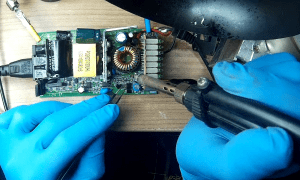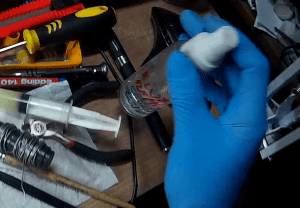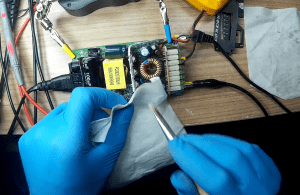The use of flux is essential when soldering electronic components. By removing impurities such as dirt, oils and oxidation, it helps to achieve a stronger solder joint. The contaminants could be removed by mechanical or chemical cleaning prior to soldering, however, high temperatures required during the soldering process would cause an element to re-oxidize and thus prevent a successful solder joint. There are essentially three types of flux – water soluble flux, no-clean flux and traditional rosin flux. Rosin flux is highly corrosive so it needs to be removed after soldering, still, why would you want to remove a no-clean flux residue?
There are a few reasons:
- gummy residue prevents test accuracy when doing in-circuit testing
- it prevents an adhesion of conformal coating
- to improve the cosmetic appearance of the board
- to prevent dirt buildup
The homemade flux remover is able to remove the rosin based, non-rosin based and no-clean flux. It works better than some commercially available products and it doesn’t leave any residue when used properly. It can be used on circuit boards and on most of the plastic parts (discoloration may occur on some plastics).
Requirements:
- 850ml +95% pure denaturated Ethanol (also called: ethyl alcohol)
- 100ml +95% pure Isopropyl alcohol (also called: isopropanol, 2-propanol, IPA)
- 50ml Ethyl acetate (also called: ethyl ethanoate, EtOAc or EA)
- Liquid measuring euqipment
- 100ml spray bottle (Not essential)
- Protective gloves
If you use different units, please use a friendly liquid volume converter – https://www.thecalculatorsite.com/conversions/liquidvolume.php
Mixing procedure
Safety first: put on protective gloves to avoid damage to your skin. Work in a well ventilated area and remove all sources of ignition.
Purity of the Ethanol and Isopropyl alcohol is essential, both should be at least 95% pure. Additives such as water greatly reduce the cleaning effectiveness and could leave residues on the board. If you bought Ethanol in a 1L container, it’s best to use its container for storage of the homemade flux remover. Take a liquid measuring cup and pour off 150ml of the Ethanol from the container. Add 100ml of Isopropyl alcohol and 50ml of Ethyl acetate to the 850ml of the Ethanol in the container. Mix thoroughly. You have made one litre of flux remover, that quantity should suffice for quite some time. For practical purposes I pour some of the flux remover into the 100ml spray bottle and save the rest for later use.
Flux removal procedure
After every rework on a printed circuit board, I remove the flux residue for the above mentioned reasons. I spray the flux remover onto the contaminated area and wait a few moments for it to start dissolving the flux residue. After a minute I put a lint free cleaning wipe over it and start brushing over with a toothbrush or small painters brush. The dissolved flux residue sticks to the wipe and is therefore not spread around the board. Repeat the cleaning step, using the clean portion of the wipe, until the board is clean. Discard the wipe and use a new one when there is a high amount of flux residue on it.
Word of caution
Electronics repair is not difficult but it requires a lot of patience, calmness, focus, a steady hand and some common sense. When in doubt or when you do not fully understand something, educate yourself first by googling, before following the step in question. If you do not feel competent enough to follow a given procedure it is best to seek help from an expert technician in your area. I cannot be held responsible for any damage caused to yourself, your equipment or to the device you are repairing as a result of following this tutorial.
If you have found this blog post useful and would like to buy me a cup of coffee, please click here :)



“You have made one litre of flux remover, that quantity should suffice for quite some time”
I do not agree, look at that
http://hackaday.com/2011/06/07/cleaning-flux-from-pcbs-the-easy-way/
Dear CARMICHAEL1960,
if you submerge the whole PCB into the flux remover solution, then yes, the solution becomes contaminated quickly.
But if you follow the flux removal procedure from my post, then it will last you quite some time.